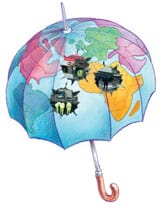Despite the lessons learned in recent terror attacks, companies are still unprotected against the catastrophic losses they could face in the event of another attack.

Four years after the terrorist attacks on the World Trade Center in New York and the Pentagon in Washington, DC, there are gaping holes in the insurance coverage available to compensate corporations for losses following any future large-scale attack, according to industry experts. The 9/11 attacks caused insured losses of more than $30 billion, making them the single most costly event ever recorded in the history of the insurance and reinsurance industry.
Scenarios in which total insured losses from a single event could exceed $250 billion are now considered as plausible, terrorism experts say. Under current conditions, such catastrophic attacks, or the accumulation of medium-size terrorist attacks within a limited time frame, may remain beyond the capability of the insurance industry to absorb alone, according to the Paris-based Organization for Economic Cooperation and Development (OECD).
A major terrorist attack could bankrupt companies and destabilize some economies, the OECD warned in a report released just two days before the London bombings in July. Data on estimated maximum losses from terrorist attacks provided in the report are not meant to be alarmist or to scare the readers, but to raise awareness of the magnitude of potential risks entailed by new forms of terrorism, and to put the issue of market capacity into perspective, says Ccile Vignial, principal administrator of the financial affairs division at the OECD, who directed the study.
In the United States, for example, the property and casualty insurers surplus supporting all commercial property, general liability and workers compensation insurance is about $114 billion, according to the Insurance Information Institute.
Terrorism insurance market conditions regarding prices and extent of cover have improved substantially since 2001, when there was a drastic shrinkage of affordable insurance following the attacks on the US, Vignial says. But terrorism risk unpredictability remains a very big challenge for the insurance industry, she says.
No country can claim to be protected from the potentially devastating impact of future attacks; moreover, direct property losses may turn out to be small compared to the global economic, social and political damage that may ensue, the OECD report says. The threat of future attacks might affect the economic outlook and investors behavior, compounding losses for insurers, the report adds. The heavy losses suffered by insurers and re-insurers from the 9/11 events combined with the downturn in the financial markets resulted in a capital loss to the global P&C; industry of an estimated $200 billion. Peter Ulrich, managing director of enterprise risk management at Newark, California-based Risk Management Solutions, or RMS, says terrorism risk insurance rates are likely to go up and capacity will decrease following the bombings of the London subway and the Sharm el Sheik resort in Egypt in July. |
Because of the potential magnitude, spread and persistence of damages caused by CBRN attacks, these exposures are for the time being generally considered as uninsurable by the insurance industry and are excluded from most coverage, according to the OECD study. It says CBRN risks represent a growing source of concern, since these methods may be an increasingly plausible scenario of attack.
The RMS model provides insurers and re-insurers with the first worldwide view of their catastrophe-risk accumulations, Ulrich says. Corporations can use the model to determine the safest locations to build plants or office buildings. People who have an interest in a number of buildings, such as bankers with commercial mortgages, also use these tools, Ulrich says. By entering data for how close they are to a particular target and what type of building they are in, they can quantify property and human-life exposures, he says.
A mere 4 grams of botulinum toxin dropped into a milk-production facility could cause serious illness and even death for 400,000 people in the US, according to Lawrence M. Wein, professor of management science at Stanford Graduate School of Business. Any food product that goes through large-scale storage and production and rapid distribution could be at risk for such an attack, he says. |
Aaron Davis, vice president of property syndication at insurance broker Aon in New York, says the insurance market cannot operate without some form of a terrorism risk backstop. A government safety net is needed to maintain terrorism insurance availability at an affordable price, he says. However, a June 30 report from the US Treasury recommended against extending the current program of government guarantees when it expires at the end of 2005. The Treasury report downplayed the potential for market disruption and was unrealistic in its assessment of the private industrys ability to provide cover, Davis says.
Treasury secretary John Snow told the House Financial Services Committee on July 13 that continuing the program would hamper the development of a private market for terrorism risk. Snow said the Bush administration would accept a temporary extension of the post-9/11 program only if it included an increase in the percent of the losses paid by commercial insurers, as well as a large increase in the amount of losses that would trigger government participation. Any compromise agreement to extend the federal program will look quite different from the backstop currently in place, Aons Davis says.
Among OECD countries, public-private partnerships exist in Australia, France, Germany, the Netherlands, Spain and the United Kingdom, as well as the US. Terrorism insurance take-up rates remain low, however, the OECD says. Less than 3% of eligible firms have contracted with the German compensation scheme, it says. About half of all companies are insured for terrorism risks in the US.
Capital markets may in the future provide some additional sources of capacity to cover terrorism risks, the OECD says, although there have only been two transactions to date explicitly covering such exposure.
In September 2003, Golden Goal Finance issued $260 million of bonds to investors who took on the risk of cancellation of the 2006 World Cup soccer championship in Germany. The investors, mainly banks, will lose 75% of their investment in the event of cancellation of the final competition. Zurich-based Fdration Internationale de Football Association (FIFA), the world soccer federation, opted for this cancellation bond, which was structured by Credit Suisse, after insurers withdrew from the last World Cup cancellation policy in 2002 as a result of the 9/11 attacks. In the only other publicly announced terrorism-related offering, Swiss Re sold $400 million of notes in December 2003 for Vita Capital to cover catastrophic mortality risk in five countries from any source, including epidemics, natural disasters, wars or terrorist attacks. |
Gordon Platt






